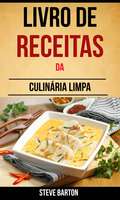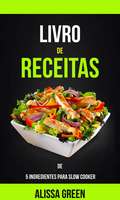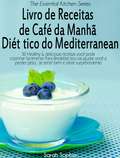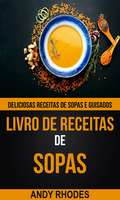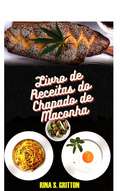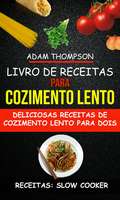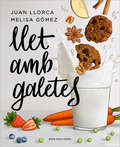- Table View
- List View
Livro de Receitas Ganhadoras da Fita Azul na Feira do Condado Receitas de Bolos Especiais
by Amber Richards Fabiana Rodrigues Castelo BrancoPrepare os bolos premiados em sua própria casa para a família e os amigos. R eceitas caseiras, autênticas e aprovadas que fazem as papilas gustativas palpitarem e se revelam perfeitas sempre. Os Livros de Receitas Ganhadoras da Fita Azul na Feira do Condado serão os mais novos fundamentos de sua coleção de receitas. Cada receita foi reunida a partir de ganhadores de grandes prêmios ou da fita azul em feiras estaduais e do condado do país. Eles impressionaram os jurados; agora você impressionará os seus amigos! Mais de 50 receitas deliciosas perfazem este livro com bolos diferenciados que certamente serão o máximo. Experimente estas receitas de bolos, que simplesmente poderão se tornar as favoritas da família, e algo de que você se orgulhará ao trazer para as refeições entre amigos. Atente contudo, que você poderá se tornar "famoso" pelos seus bolos especiais. Há bolos de canecas, bolos anelares, bolos para café, e muito mais para se descobrir. Se você está procurando partircipar de alguma competição em feiras de condado com um bolo, considere a utilização de algumas destas receitas de bolos aprovadas. Colecione todos os livros de receitas nesta série para uma boa alimentação. De tortas a saladas; doces a caçarolas; e biscoitos a entradas principais, você pode cozinhar como um ganhador da fita azul! Este é o segundo livro da série, adquira o seu agora.
Livro de Receitas Low Carb: Receitas Deliciosas de Dieta Low Carb. Melhores Receitas Low Carb
by Jason Thawne Tânia Regina Carvalho Santos LeiteDevido ao fato de que o nosso cérebro não gosta da maioria das dietas que apenas restringe a quantidade de alimento que ingerimos o que faz com que acabamos desistindo, porque passar fome o tempo todo não é a solução. A dieta Low Carb, ao contrário, proporciona um estilo de vida que faz com que você aprecie a comida e o ato de comer, além de proporcionar muitos benefícios para sua saúde. Atualmente, nossa dieta possui alto teor de carboidratos, o que faz com que tenhamos que lidar com doenças cardíacas, diabetes e pressão alta, entre outras. Embora os carboidratos sejam excelentes e a principal fonte de combustível para o corpo, seu consumo em excesso é prejudicial para a saúde. Portanto, se quiser reiniciar seu corpo e ainda perder alguns quilos, a dieta low carb é a ideal. Este livro é para você. •que quer ter um estilo de vida low-carb. •que deseja perder peso sem perder tempo. •que deseja obter receitas básicas e comprovadas para que possa usá-las imediatamente e começar a perder peso. Devido ao fato de que o nosso cérebro não gosta da maioria das dietas que apenas restringe a quantidade de alimento que ingerimos o que faz com que acabamos desistindo, porque passar fome o tempo todo não é a solução. A dieta Low Carb, ao contrário, proporciona um estilo de vida que faz com que você aprecie a comida e o ato de comer, além de proporcionar muitos benefícios para sua saúde. Atualmente, nossa dieta possui alto teor de carboidratos, o que faz com que tenhamos que lidar com doenças cardíacas, diabetes e pressão alta, entre outras. Embora os carboidratos sejam excelentes e a principal fonte de combustível para o corpo, seu consumo em excesso é prejudicial para a saúde. Portanto, se quiser reiniciar seu corpo e ainda perder alguns quilos, a dieta low carb é a ideal. Este livro é para você. •que quer ter um estil
Livro de Receitas Práticas (Receitas: Slow Cooker)
by Sam Parker JessicaLivro de Receitas Práticas – O que tem para comer? As melhores receitas de fácil preparo, sem estresse e sem bagunça – passe mais tempo aproveitando sua refeição e menos tempo preparando! Você está muito ocupado para comer direito? Você regularmente pega comida para viagem que não é saudável? Você gostaria de encontrar uma forma fácil para ter a nutrição que seu corpo precisa? ESTE LIVRO DE RECEITAS foi criado para pessoas como você, que estão OCUPADAS, mas ainda assim querem ter uma refeição caseira para comer sem passar horas preparando. A melhor parte destas receitas é que cada uma pode ser preparada e cozida com pouco tempo e esforço! Por causa do excesso de compromissos, geralmente recorremos a algo rápido e fácil, talvez uma comida para viagem. No entanto, isso pode custar caro, e não é a melhor opção para manter a saúde da família. Refeições práticas são a perfeita solução para esse problema e, neste livro, você terá a oportunidade de selecionar uma receita diferente para cada dia do ano, com 365 receitas fáceis diferentes. Encontrar tempo para fazer uma refeição decente pode ser quase impossível com nosso excesso de compromissos, então acabamos indo a restaurantes e fast-foods que, além de ruins para a saúde, nos tiram muito dinheiro! Com o Livro de Receitas Práticas: deliciosas receitas práticas, você pode esquecer o aborrecimento de preparar refeições de boa qualidade com pouco tempo. Se você está procurando receitas deliciosas do dia a dia que são descomplicadas e cabem no bolso – este livro de receitas é para você. Já aproveitou as receitas práticas? Se não, você está perdendo e desperdiçando tempo! Se você for como a maioria das pessoas, deve estar constantemente sem tempo, e isso é quase sempre refletido na sua mesa! Felizmente, as soluções para este problema podem ser a receitas práticas – apenas misture os in
Livro de Receitas da Culinária Limpa
by Steve Barton Amanda SilveiraLivro de Receitas da Culinária Limpa - incríveis receitas fáceis e saudáveis! O autor reuniu diversas receitas fáceis, saborosas e saudáveis para você descobrir a culinária limpa.
Livro de Receitas da dieta DASH: 25 Receitas para a Hipertensão e Perda de Peso
by Karen Stewart Marta SenaReceitas lendárias da dieta DASH para perder peso! Livro de Receitas da Dieta DASH Nos últimos anos, a obesidade, a diabetes e a pressão arterial alta têm sido problemas proeminentes e potencialmente fatais que milhões de pessoas enfrentam todos os dias. O caminho para ser saudável pode parecer difícil, mas pode ter um corpo, mente e espírito mais saudável com os passos presentes neste livro. Enquanto que, em última instância, é o leitor quem determina e gere a sua saúde, este livro pode ser usado como um pedra basilar para encontrar ideias e inspiração para melhorar a sua saúde de forma rápida e eficaz. Neste livro, irá encontrar um guia rápido e fácil para seguir a dieta DASH. Ganhará 25 receitas deliciosas que o ajudarão não só a melhorar os seus níveis de pressão arterial, mas também a perder peso de uma forma saudável. Irá encontrar receitas para o pequeno-almoço, pratos principais – seja para o lanche ou jantar – e acompanhamentos que também podem servir para petiscar ou para sobremesas. A dieta DASH tem em consideração a forma de vida moderna e permite-lhe liberdade de escolha, em vez de lhe impor restrições. Pode comer comidas saudáveis sem que a palavra “saudável” esteja associada a “aborrecidas”. Tem muitas escolhas de refeições deliciosas com esta dieta e pode, finamente, recuperar o controlo da sua vida, tornando-a tão longa e saudável como possível. A sua longevidade está nas suas mãos. Estime-a e use a dieta DASH para o ajudar. Se quiser fazer uma mudança permanente nos seus hábitos alimentares, este é o livro que tem de ler! Adquira-o já!
Livro de Receitas de 5 Ingredientes para Slow Cooker
by Alissa GreenEstar ocupado não dá o direito de comer fora à noite. Enquanto comer fora é conveniente, não há certeza de que a comida que você está consumindo contém ingredientes saudáveis. O certo é que, você pode ter refeições deliciosas e saudáveis apesar da sua agenda cheia se tiver uma panela elétrica crockpot/slow cooker. Em poucos minutos de preparação, jogue os ingredientes na slow cooker e, algumas horas depois, você terá uma refeição caseira que toda família irá amar. Após um dia longo e difícil, você só precisará abrir sua slow cooker, servir e comer! Simples assim. Mas isso não é tudo: você também pode aproveitar os inúmeros benefícios de usar uma slow cooker, como: •Cozinhar com uma slow cooker requer menos tempo, esforço e recursos; •Faz com que os alimentos fiquem mais saborosos e macios; e •É útil durante o ano inteiro •Faz com que sua casa cheire bem •Pode ser usada em todas as refeições do dia, incluindo café da manhã e sobremesas. Com este livro, você pode desfrutar de suas comidas favoritas apesar de sua agenda cheia. Volte para o topo e clique no botão COMPRE AGORA no canto direito do topo da página para um download imediato!
Livro de Receitas de Café da Manhã Dietético do Mediterranean
by Sarah Sophia Eduardo Ribeiro RegoLivro de receitas culinárias do Mediterranean, referente a refeições de café da manhã dietéticos, incluindo os ingredientes e modo de preparo.
Livro de Receitas de Café da Manhã para a Dieta da Barriga de Trigo
by Sarah Sophia Mirian Sayuri VaccariLivro de Receitas de Café da Manhã para a Dieta da Barriga de Trigo Série A Cozinha Essencial, Livro 44 Por anos, os pesquisadores martelaram em nossas cabeças sobre a importância de um café da manhã balanceado cheio de nutrientes. A longevidade, e a nossa saúde em geral, também está ligada a adoção de uma rotina de cafés da manhã saudáveis. Começar cada dia com um plano de sucesso deve englobar uma dieta projetada para abastecer o corpo, aumentar a sua energia e trazer a atenção para o seu cérebro. Um passo na direção correta pode fazer toda a diferença na sua performance diária no trabalho ou em sua casa. Aprenda a apreciar a vida um pouco mais, construir um senso de confiança e adotar uma atitude de bem estar ao simplesmente modificar o que você come na sua refeição matinal. Decida fazer a diferença hoje. Se você é uma das milhões de pessoas que começam o dia pulando o café da manhã ou tomando uma xícara de café e um donut no caminho para o trabalho, agora é hora de mudar. Você está literalmente começando cada dia no pé da montanha, esperando que seu corpo e sua mente negociem cada passo com pouca ou sem energia. Talvez você não esteja realmente com fome. O lanche à noite ainda está no seu estômago, resultado da necessidade de pausa do seu sistema digestivo enquanto você dorme. E então, durante a manhã, você se sente em um monte de lama, trazendo você para baixo e dificultando a sua vida. Não precisa ser assim. Mudanças no estilo de vida, em uma direção positiva, podem e irão transformas a sua vida e não existe melhor hora que o presente para fazer um ajuste crítico importante - o café da manhã. O Livro de Receitas da Barriga de Trigo - Edição de Café da Manhã é uma leitura obrigatória para indivíduos que desejam mais energia, perda de peso e uma perspectiva positiva para começar o dia. Aprenda o que milhares de pe
Livro de Receitas de Dietas Alcalinas - O plano de refeições alcalinas para equilibrar o seu PH
by Adidas WilsonOs níveis ácido e alcalino são indicados no seu corpo através de escalas de PH. Os níveis alcalinos em seu sangue devem ser mantidos de preferência entre os limites de PH de 7,35 a 7,45. Nos limites de 7,35 de PH, seu corpo se encontra altamente ácido e propenso a uma variedade de doenças. O consumo de alimentos altamente ácidos extrai minerais como cálcio, magnésio, potássio e sódio dos depósitos ósseos, mediante a regulação dos níveis de ácido. Um dos melhores livros que você encontrará na amazon. Uma grande saúde começa com o conhecimento, e este livro ajudará a reduzir os níveis de ácido e também ajudará qualquer pessoa em sua jornada de perda de peso.
Livro de Receitas de Doces Assados: 25 Receitas Deliciosas de Doces Assados (Sobremesas)
by Emi Watson Debora SantosAsse suas guloseimas preferidas – Hoje mesmo! Leia este livro em seu computador, Mac, smartphone, tablet ou dispositivo Kindle! Ao ler o Livro de Receitas de Doces Assados: 25 Receitas Deliciosas de Doces Assados, você entrará em um novo mundo de sabores e prazeres. Você obterá percepções essenciais sobre técnicas de panificação e alimentos assados. Este livre lhe ensina a assar suas guloseimas favoritas: •Bolo de banana fantástico •Bolo de chocolate de liquidificador extraordinário •Bolo de chocolate cremoso rápido e básico •Bolo brownie de chocolate formidável •Bolo de abóbora com caramelo maravilhoso •Bolo de laranja amanteigado misterioso •Bolo bundt fantasia de amora-preta •Bolo saboroso de morango com amêndoas •Bolo de banana fantástico •Bolo de banana de outro mundo •Bolo atraente de molho de maçã com gengibre cristalizado •Bolo de manteiga de amendoim com banana de dar água na boca •Bolo insano de melado com pera e maçã •Bolo espetacular de mirtilo •Bolo maravilhoso de chocolate com leitelho Não espere mais! Baixe hoje mesmo sua cópia e comece a conquistar o coração da sua família com suas guloseimas assadas! Não gaste mais dinheiro com petiscos ou bolos da padaria. Agora, você pode cozinhar em sua própria casa e colocar um toque de amor em tudo o que fizer. Coloque seu avental e vamos começar a assar!
Livro de Receitas de Sopas: Deliciosas receitas de sopas e guisados
by Andy Rhodes Rod Di PaolaNão existe melhor maneira de cultivar comunidade, fomentar a amizade ou simplesmente nutrir a família do que acompanhado sopas caseiras bem quentes. Se você está procurando por receitas deliciosas de sopas para o dia a dia que ajude a satisfazer sua família e seu bolso, esse é o livro de receitas para você. Esse livro é uma compilação de grande variedade de receitas de sopas de diferentes países do mundo. Ele representa a cultura culinária de cada lugar de origem com o uso de diferentes sabores e combinações de ingredientes, ainda que as receitas sejam flexíveis e ajustáveis de acordo com o gosto pessoal de cada um. Algum desses pensamentos já passou pela sua cabeça? •Eu não tenho tempo suficiente para cozinhar. •Eu não sei por onde começar ou o que fazer. •Leva tempo demais para fazer minha própria comida. •Cozinhar é complicado demais!!(Isso é um mito) Seus problemas estão solucionados --> RECEITAS FÁCEIS PASSO A PASSO! Esse livro simples e fácil vai te ajudar... Economize tempo e dinheiro Faça mais sopas caseiras Aprenda a cozinhar com receitas e instruções simples
Livro de Receitas do Chapado de Maconha
by Rina S. GrittonCom o conhecimento cada vez maior e a legalização generalizada da maconha, a relação tensa do público em geral com essa planta milenar começou a diminuir. O esconderijo secreto de botões de cannabis escondidos nos cantos escuros de sua cozinha agora pode ocupar o lugar do orgulho em seu armário de cozinha para o mundo inteiro ver. Posso apostar que o pensamento fugaz de cozinhar com cannabis deve ter rodado em sua mente até você abandonar a ideia. A maconha foi dramaticamente estigmatizada e isso nos levou a perder muitos benefícios significativos para a saúde. Esta bela planta nativa da África e do Oriente Médio é principalmente cultivada por suas propriedades psicoativas e também usada para fins medicinais. Cozinhar com maconha é uma excelente oportunidade para você experimentar as diferentes facetas do paladar que sua língua realmente merece. "Marijuana Stoner Chef Cookbook; Um guia para iniciantes em receitas de cannabis simples, fáceis e saudáveis" é um livro que irá guiá-lo sobre como preparar iguarias de dar água na boca com os poderes mágicos da maconha. Esta erva que é incrível quando adicionada aos seus pratos e bebidas recreativas irá melhorar a sua saúde e fazer você se sentir relaxado. Este livro contém receitas de refeições, lanches, molhos, bebidas e muito mais que tem excelentes benefícios para a saúde e culinária para você e para aqueles ao seu redor pelo consumo regular desta erva. Alguns dos benefícios de comprar e ler este livro incluem, mas não estão limitados a; Ter um conhecimento relativamente básico do que é cannabis Como você pode melhorar sua saúde usando-o O que procurar quando consumido de várias maneiras A melhor forma e método de cozinhar com maconha Ótimas receitas para você preparar na sua cozinha Reserve um tempo para ler e colocar em prática as dicas listadas neste livro para deixá-lo mais confortável para cozinhar, e fazer uso d
Livro de Receitas para Cozimento Lento: Slow Cooker)
by Adam Thompson Gilson Cardozo de ArrudaQUER APRENDER RECEITAS DELICIOSAS COM O USO DA PANELA ELETRICA PARA VOCÊ E TODA SUA FAMÍLIA? Se você quer aprender receitas excelentes para você ou para toda a família, este livro irá ajudá-lo! Você deseja ter mais tempo para cozinhar em casa? Gostaria de dar à sua família os melhores ingredientes e os mais frescos? Você adora o aroma de uma refeição saudável preenchendo a casa no final do dia? Você não precisa ser um especialista para preparar refeições rápidas e saborosas para você e sua família. Não importa seu nível de habilidade, você pode aprender a arte de cozinhar e aproveitar os prazeres de uma refeição caseira! Receitas com a PANELA ELÉTRICA é uma nova e moderna abordagem de refeições que ganhou cada vez mais terreno nos últimos dois anos, resultando em uma série de vantagens, tais como: • Cozinhe lentamente as refeições por um período prolongado • Permita que os sabores se desenvolvam de forma lenta e constante • Economia • Seguro para usar • Eficiente • Mais saudável e mais nutritivo Este e-book incorpora uma variedade de receitas, desde frango, cordeiro e carne bovina. As receitas são compostas de ingredientes simples que são fáceis de preparar, seus sabores característicos e equilibrados e usando especiarias o suficiente para transformar uma receita padrão em uma formidável! A panela elétrica é bastante útil e esperamos que nossas receitas se tornem mais fáceis e mais interessante para usá-las em todos os dias. Volte para o topo da página e selecione o botão Comprar Faça o download da sua cópia agora mesmo!
Livro de receitas Dieta Paleo (Paleo Diet)
by Ted Cage Rafael GaspariniA dieta Paleo pode te ajudar a decifrar quais alimentos são mais saudáveis para você e pode encurtar o seu tempo de compras eliminando as comidas processadas. Se alimentarde forma mais saudável e perder peso já são razões suficientes para testar a dieta paleo, mas tem um benefício adicional que vai além da perda de peso.
Livro de receitas de panela de pressão: Pressure Cooker)
by Juliana Dias Borges Clark PetersonDescubra estas receitas surpreendentemente rápidas e fáceis de sobremesas de panelas de pressão! Se você está procurando preparar sua sobremesa favorita ou clássica, ou se você estiver com vontade de descobrir algo novo, este livro tem tudo o que você está procurando. Você pode facilmente virar o livro e ficar impressionado com as receitas versáteis que você pode preparar, tudo com a simples panela de pressão. Os benefícios de usar uma panela de pressão, como você já deve saber, é que a comida cozinha em quase metade do tempo, o que significa que você poderá desfrutar suas sobremesas caseiras muito mais rapidamente! Cozinhe rapidamente seus alimentos favoritos, economize energia e aproveite todas as últimas mordidas. A panela de pressão é uma ótima alternativa aos métodos tradicionais de cozimento, como a estofação, mas leva muito menos tempo. O calor elevado dentro da panela de pressão cozinha rapidamente sua comida, mas não poupa nenhuma despesa no departamento de sabor. Este livro contém as melhores receitas de panelas de pressão no mundo. A questão é que você vai escolher aprender este método incrível de cozinhar do jeito certo ou você continuará a fazer as mesmas receitas aborrecidas? Se você está pronto para começar a fazer refeições deliciosas com pressão deliciosa, desligue-se para cima e pegue sua cópia do Cookbook de Culinária de Pressão para Iniciantes.
Livro de receitas na panela de pressão: Pressure Cooker)
by Luiza Brando Darren WayneFique esperto – aproveite ao máximo sua panela de pressão! No livro, você encontrará receitas para todos os gostos, não importa para quem você está cozinhando ou qual evento você está oferecendo. Desde sopas simples e rápidas até jantares deliciosos e muito mais, há diversas receitas na panela de pressão presentes nesse livro que vão agradar a todas as pessoas! Prepare-se para se encantar com refeições para o café da manhã feitas na panela de pressão, como a quinoa matinal e os ovos cozidos instantâneos. No almoço e no jantar, você pode servir muitas outras delícias! Não espere mais, adquira sua cópia do Livro de receitas na panela de pressão: 25 receitas deliciosas na panela de pressão hoje mesmo!
Livro de receitas: Descubra e experimente novos hambúrgueres recheados e de dar água na boca
by Michael Stone Fabielle CruzDescubra uma variedade de pratos emocionantes com o guia surpreendente das melhores 50 melhores receitas de hambúrguer. Dentro deste livro de receitas, você aprenderá a fazer alguns dos mais deliciosos pratos de hambúrguer que irão rivalizar com alguns dos restaurantes de hambúrguer mais populares, como o McDonald's ou o Burger King; com a ajuda de mais de 50 receitas de hambúrgueres que impressionarão mesmo os mais seletos dos comedores, como um hambúrguer de guacamole, um hamburguer Caprese ou mesmo um cremosíssimo cheddar. O seguinte livro de receitas lhe dará algumas ideias novas e manterá a grelha acesa. Algumas são excelentes receitas para as crianças tentarem também. De amantes de carne para vegetarianos, há um hambúrguer neste livro de receitas para você! Então vamos ligar a grelha ou puxar a frigideira e vamos cozinhar!
Livro de receitas: Detox Receitas)
by Renato Santana dos Santos Garry BrownReceitas para Comer Limpo são simplesmente incríveis!! ★★★★★ Livro de receitas: Comendo Limpo: 25 Deliciosas Receitas para Comer Limpo (Receitas: Detox Receitas) ★★★★★ Obtenha incríveis Receitas para Comer Limpo!! Comer comida super processada ou fast food pode ter um impacto negativo na sua mente e corpo ao longo do tempo. Seu corpo pode tornar-se preguiçoso e sua mente também pode parar de funcionar adequadamente – fadiga, não sendo capaz de focar da maneira correta, todos efeitos da fatal de uma dieta pobre em nutrientes. Seu corpo e mente te sabotando é o pior sentimento de todos! Mas é hora de voltar ao início! Mude seu estilo de vida hoje, comendo comida mais próxima do seu estado natural, comida com mais nutrientes do que química. Este livro contém todo o necessário para começar a fazê-lo! A partir de explicações fáceis de entender do que é uma comida limpa, até toda uma gama de receitas, a informação encontrada nestas páginas é suficiente para te dar um bom início em direção a uma saúde aprimorada, mais energia e um melhor estado mental.
Livro de receitas: Maravilhosas Receitas Para o Preparo de Sobremesas, Receitas de Sobremesas em Taças
by Gilson Cardozo de Arruda Miley CassidyEu venho de uma pequena família que sempre se certificou de que comeríamos uma sobremesa incrível. Se você está procurando algo diferente, algo para satisfazer seus desejos, então leia essas receitas requintadas que darão água na boca. Você ainda pode desfrutar de cheesecakes e deliciosos biscoitos de chocolate. Seus Problemas Serão Resolvidos ==> PRÁTICO, RECEITAS PASSO A PASSO! Existe algo especial nestas sobremesas - Elas são mais elegantes e saudáveis que a maioria dos doces e são simplesmente incríveis. Ainda melhor é que preparar sobremesas caseiras é fácil o suficiente, até mesmo para um cozinheiro inexperiente. Algumas das principais características deste livro: •Não será necessário nenhum utensílio sofisticado de cozinha. •Ingredientes fáceis de encontrar. •Instruções simples e rápidas. Não há truques! •Delicioso. Agora que você sabe mais sobre este livro e porque ele foi feito para você, não se esqueça de rolar a página e clicar no botão de compra acima para que você possa começar aproveitando as receitas de sobremesas agora mesmo!
Livro de receitas: inclui 35 receitas sob vácuo deliciosas
by Lani Schinner Kauã Maciel MedeirosReceitas fantásticas sob vácuo... Você quer tirar o máximo proveito da sua máquina a vácuo? Você está procurando consistentemente preparar comida excelente com um esforço mínimo? Se você assentiu com a cabeça "Sim", este livro foi escrito para você! Sem dúvidas, o método de cozinha do Sous Vide é a maneira perfeita de impressionar seus convidados com alimentos saudáveis e com qualidade de restaurante preparados pelas suas mãos. Se você está procurando para cozinhar sob vácuo, você está no lugar perfeito para conhecer algumas das melhores receitas sob vácuo. Estes são simples, simples e acima de tudo, receitas saborosas. E mesmo que você não tenha muito tempo para gastar na cozinha, não se preocupe. Isso também é amigável com o tempo. Neste livro, você encontrará: •Capítulo 1 - O que é cozinhar "sous vide"? •Capítulo 2 - Segurança alimentar é importante •Capítulo 3 - Passo a passo do processo 'sous vide" •Capítuilo 4 - Perguntas frequentes respondidas sobre "sous vide" Receitas sous vide Imagine que agora você pode cozinhar o bife suculento e os vegetais perfumados que têm o mesmo gosto que em restaurantes luxuosos!!!
Lizzie Loves Healthy Family Food: Delicious and Nutritious Meals Youll All Enjoy
by Lizzie King'Not only is she a brilliant cook, but she fundamentally knows what is good and what is bad in food.'Thomasina MiersLIZZIE LOVES HEALTHY FAMILY FOOD is the cookbook every health-conscious parent needs in their life.Nutritional health coach and mum of three Lizzie King knows how tough it can be to feed a family, fast, and keep them healthy: lack of time, fussy eaters and weaning babies can make any alternative to cooking from scratch seem tempting.LIZZIE LOVES HEALTHY FAMILY FOOD is here to help. Every recipe is quick-to-make, delicious, bursting with flavour and all the vitamins and minerals you and your children need to stay healthy. Every meal is free from refined sugar and gluten, and is instead packed with as much good stuff as possible.With an eye on cutting down prep time and making one meal work for everyone, LIZZIE LOVES HEALTHY FAMILY FOOD is the busy parent's dream. You'll also find Lizzie's invaluable ten-step guide to cracking fussy eaters, nutritional information on what children need when and why, and a handy shopping list for your store cupboard staples. No longer will you stare blankly into the fridge wondering what to cook your kids next! Complete with over 100 wholesome and delicious recipes, helpful meal plans and practical short cuts, LIZZIE LOVES HEALTHY FAMILY FOOD is the only cookbook you and your family need to eat well, and be well, for life.
Lizzie Loves Healthy Family Food: Delicious and Nutritious Meals You’ll All Enjoy
by Lizzie King'Not only is she a brilliant cook, but she fundamentally knows what is good and what is bad in food.'Thomasina MiersLIZZIE LOVES HEALTHY FAMILY FOOD is the cookbook every health-conscious parent needs in their life.Nutritional health coach and mum of three Lizzie King knows how tough it can be to feed a family, fast, and keep them healthy: lack of time, fussy eaters and weaning babies can make any alternative to cooking from scratch seem tempting.LIZZIE LOVES HEALTHY FAMILY FOOD is here to help. Every recipe is quick-to-make, delicious, bursting with flavour and all the vitamins and minerals you and your children need to stay healthy. Every meal is free from refined sugar and gluten, and is instead packed with as much good stuff as possible.With an eye on cutting down prep time and making one meal work for everyone, LIZZIE LOVES HEALTHY FAMILY FOOD is the busy parent's dream. You'll also find Lizzie's invaluable ten-step guide to cracking fussy eaters, nutritional information on what children need when and why, and a handy shopping list for your store cupboard staples. No longer will you stare blankly into the fridge wondering what to cook your kids next! Complete with over 100 wholesome and delicious recipes, helpful meal plans and practical short cuts, LIZZIE LOVES HEALTHY FAMILY FOOD is the only cookbook you and your family need to eat well, and be well, for life.
Lizzie's Amish Cookbook: Favorite Recipes From Three Generations Of Amish Cooks!
by Linda BylerLizzie Glick moves from "running around" to the adventures and anxieties of adulthood in the three-book series, Lizzie Searches for Love. But one characteristic remains ever-present in all the books: Lizzie's love for food! Now you can make Lizzie's homemade oatmeal bread with strawberry jam and her tantalizing creamsticks. Lizzie's Cookbook is a collection of over 175 easy-to-follow recipes for the food that Lizzie cannot resist. The recipes were selected by author Linda Byler's daughter, Laura Ann Lapp, who spent hours with her grandmother poring over her well-worn cookbooks for the best of Amish cooking. From Chicken Stew with Dumplings to Veggie Soup and Homemade Pizza, from Pumpkin Whoopie Pies to Garden Mint Tea, this collection of recipes is sure to bring you as much pleasure as it does Lizzie. This recipe-packed book joins the three books in the Lizzie Searches for Love series and cites the passages in their pages where Lizzie picked up her fork and dug in with finger-licking vitality.
Llet amb galetes
by Juan Llorca Melisa GómezLa cuina de sempre amb els aliments d'ara. Els autors de Sense dents i a mossegades conviden els avis a la seva revolució de l'alimentació saludable. Els autors del best seller Sense dents i a mossegades tornen a ajuntar-se per mostrar-nos un nou enfocament en nutrició infantil i familiar. Llet amb galetes ofereix una sèrie de consells nutricionals que contribuiran a l'harmonia entre les diferents generacions de la família, així com informació nutricional per elaborar els nostres menús. El llibre inclou, a més, cinquanta receptes de menjars, sopars i berenars pensats amb aquest enfocament, una fusió de la tradició culinària dels nostres avis amb les necessitats nutritives dels més petits.
Lo Esencial de Atkins
by Atkins Health Medical InformationMillones de personas en todo el mundo ya han descubierto el Método de Nutrición Atkins y los tremendos beneficios conseguidos al controlar el consumo de carbohidratos. Ahora es aún más fácil unirse a esta revolución, perder el peso deseado, y gozar de perfecta salud siguiendo estos sencillos pasos. Menos científica y con un contenido más práctico, esta guía enfoca la esencia del programa de control de peso más eficaz del mercado, brindando las herramientas y capacitación necesarias para perder grasa corporal -- desechándola ¡para siempre! Con respuestas claras y concisas, Lo Esencial de Atkins es ideal para todo aquel en busca de un estilo de vida más saludable. Y para novatos, es una forma rápida y efectiva para comenzar. Los ya familiarizados con el programa, encontrarán tips indispensables sobre qué hacer al salir a cenar, al hacer compras, y mucho más.



